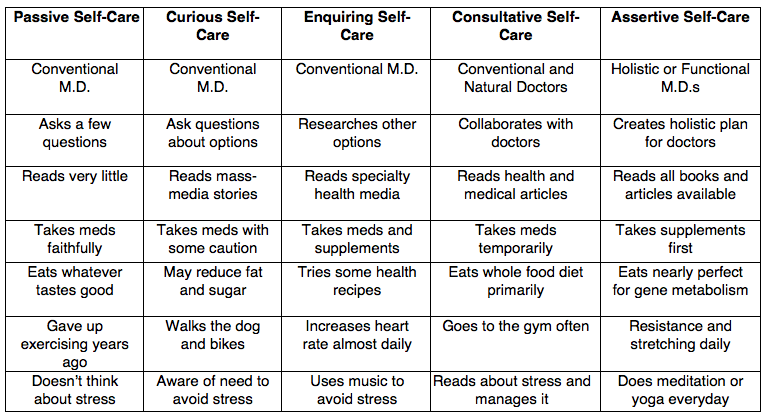PREVENTATIVE HEALTHCARE:
SHIFTING THE SELF-CARE PARADIGM
Part 1
The existing healthcare system is based on the treatment of symptoms, even though 80 percent of illness is preventable. That means simply that individuals and their doctors are doing precious little to prevent disease. This has led to a declining state of health, as well as outrageously high health costs, rising every year.
More than 60% of adults have a chronic illness, and this represents a six-fold increase over the past sixty years. Cost in that same period of time has tripled from 7% of our Gross National Product to about 20%.
How did this happen, and can anything be done to reverse this critical situation? Several specific factors have contributed to this disappointing state of affairs. Following is a partial list of factors:
- The general public learns very little about health and prevention in the educational system, the media, or the workplace.
- Conventional health practitioners learn very little about prevention or natural approaches to reversing chronic disease.
- The existing health insurance system is almost exclusively focused on treatment, with rules and regulations slanted in that direction.
- Scientific studies clearly show that conventional medical treatments are effective only about 20-25% of the time.
- Prescription drug companies have amassed billions of dollars from their treatment-based approaches and then use this war chest to keep the treatment-based system intact and keep the money flowing to company executives and shareholders.
- The media plays a big role in supporting the treatment-based system by virtue of the rich advertising budgets provided to both electronic and print media by “Big Pharma.”
- Governmental agencies play an important role in this support of treatments. Political campaigns are funded by drug companies, to ensure that rules require strict legislative guidelines and expensive clinical trials that can only be paid for by rich drug companies, not innovative startups.
It is very clear that the current healthcare system is stacked very much in favour of treatment, with prevention given very little attention. This is in spite of the fact that scientific evidence is heavily weighted in favour of prevention – and even reversal – of chronic disease. The “system” simply ignores this fact and allows the financially lucrative treatment-based system to continue to have its way.
Is there any hope that this situation can be changed? Let’s consider self-care as one of the options that warrant further attention. Self-care can be described as common sense healthcare, whereby people take more responsibility for their health, with an emphasis on prevention.
Unfortunately, too many people pay little attention to prevention. This results in a medical response and a treatment of some kind by our conventional healthcare system. Besides being expensive, this treatment-based approach represents the number one threat to the health of our country.
About 95% of all health expenditures are related to the treatment of illness; only 5% is spent on prevention. This is disturbing, because over 80% of all illness is preventable. This means that, in the purist scenario, over 80% of healthcare costs are also preventable.
This is why the United States has the most expensive healthcare system in the world, and it it is on track to bankruptcy. Too many people have become “addicted” to the treatment of disease. This addiction will eventually make many people sicker and cause them to die sooner than they should. Self-care can be defined in many ways, and we should carefully consider its many variations in order to optimise the opportunity for illness prevention and cost savings.
Part 2
1. Passive self-care – Favoured by many conventional doctors. It involves asking some general questions about the diagnosis as well as the recommended treatment for a particular illness. Some doctors do not even want to entertain questions, since they feel that patients know so little about medicine that they are not qualified to challenge or question a doctor’s diagnosis or treatment.
2. Curious self-care – In this case, patients may ask some questions of their primary care physician and, if not totally satisfied, might seek a second or even third opinion. This level of self-care usually kicks in when a more serious illness is diagnosed, and the patient wishes to avoid an operation, or an invasive treatment, such as chemotherapy. The patient may also be frightened enough to ask about less invasive treatment possibilities. However, at the conclusion of this discussion, the conventional doctor’s opinion would probably prevail.
3. Inquiring self-care – This level of self-care is similar to “curious self-care,” with the exception that individuals, would do some research in order to prepare better questions, especially for the second and third opinion doctors. They may even suggest some complementary or alternative treatments, but would not press for them if their doctor discouraged their use. The other distinguishing characteristic of this type of self-care is that it is mainly reactive, rather than proactive or preventive.
4. Consultative self-care – This is the first self-care level that includes active prevention and consultation between doctor and patient on how to prevent illness, as well as how to treat conditions that have been diagnosed. Patients at this level are likely engaged with conventional as well as alternative practitioners on a regular basis. Some medical offices now have a full range of integrative practitioners available for patients to consult.
5. Assertive self-care – These individuals are often called self-healers. They usually consult with several alternative health practitioners on a regular basis. They will sometimes consult a conventional doctor in an emergency, but would much rather research their condition and find one or more alternative treatments for any chronic illness. They are also very engaged in illness prevention.
They sometimes believe that they will get various diseases and will take many different approaches to avoid them, including restricted diets, regular nutritional supplementation, and regular tests to ensure that nothing has actually changed in the body.
People may move from one level to another over time or change approaches depending on their situation. Some people believe that they are engaged in prevention because they eat what they believe to be a “balanced” diet, don’t smoke and get some exercise. More detailed definitions are a starting point to determine where you are in terms of personal responsibility.
The following chart illustrates the main points of these different levels of patient self-care.

Part 3
Further Defining Self-Care
Several factors contribute to self-care in its highest and best form.Here are some of the basic criteria:
Part 4
It is clear that self-care goes well beyond what happens between people and their doctors; it involves a full range of activities that can dramatically influence a person’s overall health and wellness. Self-care includes many lifestyle changes and educational initiatives. This, more than any other single health factor, is what separates a low-risk person from a high-risk person.
Far too many people take a laissez-faire attitude with their health. They don’t eat as well as they should. A recent study of more than 16,000 people aged 2 to 80 did not find even one person who followed a healthy diet. This study, from the National Cancer Institute, actually revealed that a vast majority of people were deficient in 11 out of 14 nutritional categories.
That would explain why over 60% of adults are chronically ill, compared to only 10% 60 years ago. It would also explain why the generation of children born after the year 2000 must be the first generation that will not live as long as their parents did.
Why is it taking so long for people to pay attention to these very serious health problems? Articles about this health crisis appear nearly every day, and yet most people remain surprisingly unaware about how they need to change their behaviour. Why?
- A vast majority of doctors still only treat symptoms.
- Insurance companies pay for treatments and little (less than 5%) for prevention.
- Big Pharma influences politics, through extensive advertising dollars.
- Only 20-25% of treatments by conventional medicine are supported as effective by scientific evidence.
- Workers are too busy to find time to research and implement a good disease-prevention program.
- Many workers do not have the financial ability to pay for organic food, nutritional supplements, holistic doctors, and other out of pocket health expenses.
- People tend to think they will live a long and healthy life in spite of emerging health concerns.
- People feel that their doctor will find and control any health problem if it does happen. This attitude prevails in spite of the evidence to the contrary in study after study.
The existing healthcare crisis facing our country will not be resolved soon. If 80% of disease is preventable, then the only feasible solution is to dramatically increase and improve patient self-care. This requires a revolution of new thinking on the part of all of us.
Part 5
Reforms to Increase Self-Care
Here are a few examples of some of the reforms that would help to shift the preventive healthcare paradigm in the direction of better health and lower cost.
- We need the media to pay serious attention to disease prevention.
- We need politicians to create strategies and incentives for prevention and better patient self-care.
- We need insurance companies to dedicate more time, effort, and resources to prevention.
- We need much better health education and nutrition programs in our schools.
- We need better workplace wellness programs, with tax incentives for employers and employees who practice prevention and use evidence-based natural treatments.
- We need to find, and practice, new ways to reduce stress in our schools, our families, and the workplace.
- We need doctors to learn more about nutrition and holistic medicine. Government and the American Medical Association should spearhead this change.
- We need hard prevention targets to improve overall health. Everyone needs to buy into these targets, in much the same way that we target species extinction.
The current debate about healthcare costs has centered on such things as the availability of insurance or whether prescription drugs are covered or not. There are endless debates about approval of certain treatments and the lack of time doctors have to spend with patients. While these are important issues, they pale in comparison with the importance and significance of the self-care issue.
Fixing all of the technical, administrative, and coverage issues would improve health or reduce costs as much as a shift in the self-care attitude of our population. A majority of our population is in the passive or curious self-care categories. Moving them to the inquiring or consultative categories would save billions of dollars within a matter of months. This is where our effort should be concentrated.
By tinkering with the symptoms, instead of attacking the root cause of our health problems, we continue to give in to the pressure of the almighty dollar. The protection of profits for drug companies, doctors, and certain parts of the food industry is, in a word, obscene.
The power to change this sad state of affairs may be partially addressed by government, the medical establishment, and the insurance industry; however, it can be much more quickly and effectively resolved through the decisions made by each and every person as we decide how we will define our own self-care.
Get well and stay well.
TAKE CONTROL OF YOUR HEALTH AND ESCAPE THE SICKNESS INDUSTRY.
Your guide to a long, healthful life.
Available here


